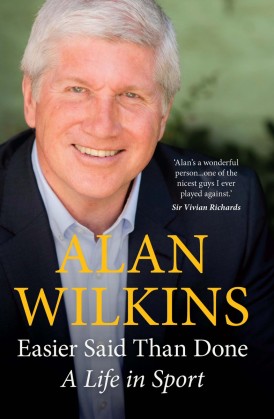Easier Said Than Done – A Life In Sport
Martin Chandler |Published: 2018
Pages: 278
Author: Wilkins, Alan
Publisher: St David's Press
Rating: 3.5 stars

The stories of cricketers’ lives, be they biographies or self-penned, should always have at least some statistics in them. For the great players, and indeed some of the not so great, these appendices can be as bulky as any chapter in the book. In Alan Wilkins’ case he only gives his reader two pages, but he certainly brought a smile to my face. Under the heading Selected Career Statistics comes the sort of gently self-deprecating observation that characterises the book; For the record, here’s my cricket career ‘at a glance’ – it won’t take long.
Wilkins made his debut for Glamorgan in 1976 at 22, and retired from there seven years later having spent a couple of the intervening summers on the other side of the River Avon in Gloucestershire. He was a left arm medium fast bowler, steady and unspectacular, but certainly a more effective performer than he would have his reader believe. As a career record 243 First Class wickets at 30.90 is by no means bad, and he must have been a decent bowler to take 8-57 at Old Trafford, but the most meaningful of the selected stats is the list of the men Wilkins dismissed most often. I can accept that even the greats will be dismissed by a spud occasionally, but I simply don’t believe that a poor bowler can have Viv Richards, Alvin Kallicharan and Gordon Greenidge on his CV a total of eleven times.
The first half of Easier Said Than Done – A Life In Sport is concerned with Wilkins’ truncated playing career. Plenty of men who played county cricket in the 1970s and 1980s have written books, but Test men tend to write about international cricket, and not the daily grind of the county circuit. For those of us who followed the county game in those days the insights Wilkins provides into that way of life are of much interest. The falling out with coach Tom Cartwright that led to the first departure from Glamorgan is illuminating, and on a lighter note I certainly enjoyed the tale of Glamorgan’s first meeting with Malcolm Marshall, the fact that the ending of that particular story is pretty obvious from the start in no way detracting from its entertainment value. In much the same vein is an account of a ‘mankading’, by Wilkins, albeit not of his own volition, of Robin Jackman.
After accepting Mike Procter’s invitation to join Gloucestershire Wilkins enjoyed the two most successful seasons of his career with his new county, but then came the injury and surgery. Wilkins missed the whole of the 1982 season and although he was back in 1983, and returned to Glamorgan, it was not a successful comeback, 12 wickets in fourteen First Class matches at 68.33 telling its own story. How often has such a season been recorded in depth in a cricketer’s autobiography? Not many must be the answer to that, but the chapter concerned is certainly one of the best in the book.
In that last summer in the game Wilkins took the first tentative steps in his broadcasting career. He began with BBC Wales but soon took opportunities overseas and is much better known now in India than anywhere else. Wilkins hasn’t confined himself to cricket either, having spent plenty of time in the worlds’ of Rugby Union and Tennis in particular, and with other sports as well.
By virtue of my lack of real familiarity with Wilkins the commentator the second part of his book was less enjoyable than the first, but it still has its moments, the passage dealing with his experiences with the game of squash and the grand old man Jonah Barrington being particularly entertaining. On the other hand I suspect audiences in India and South Africa will probably prefer part two.
Above all however Alan Wilkins is clearly a thoroughly decent bloke, something to which a number of contributors bear witness. An affectionate preface is provided by the old Indian tennis player and now co-commentator Vijay Amritraj. In a foreword Sunny Gavaskar makes the observation that Alan Wilkins has to be the nicest man in broadcasting, and explains how he fell victim to Wilkins’ bowling on the only two occasions on which their paths crossed on the field. Lining up to pay tribute to Wilkins there is also an introduction by the man who, when I was a child, was the most famous Welsh sportsman of them all. ‘Lynn the Leap’ may not have the profile today that he had then, but the 1964 Olympic long jump gold medallist, who first met Wilkins in 1990, has always been a great ambassador for his country.
Easier Said Than Done – A Life In Sport is probably not a book for those whose interest in a sporting autobiography is dependent on being able to read a few sensational revelations and controversial passages, but for the rest of us Sunny Gavaskar’s comment sets the scene for a memoir that I certainly recommend.
One final observation is to give a pat on the back to publisher St David’s Press. The book is a good quality hardback with, as noted, the essential statistics and an excellent index. The photographs are well reproduced as well, something that in the case of those from his playing days Wilkins may regret, at least as far as his hair is concerned. There is also an interesting juxtaposition of images of the delivery strides of Wilkins and Mitchell Johnson – if it weren’t for the tattoos and the hair you wouldn’t be able to tell the difference.






Leave a comment